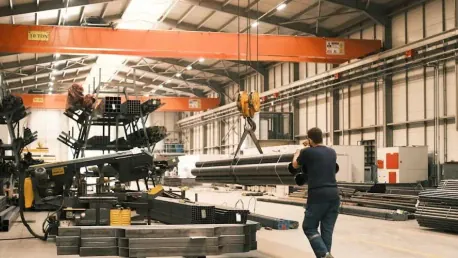The logistics industry is undergoing a significant transformation driven by the rapid growth of e-commerce and the increasing demand for faster delivery services. The coronavirus pandemic has accelerated consumer reliance on online shopping, a trend that continues to rise. E-commerce sales are projected to grow by 8.8% in 2024, and by 2027, online retail will account for 23% of global retail purchases. In the U.S., online sales represented 22% of all sales during the first quarter of 2023, underscoring the persistent demand for e-commerce platforms.
The Rise of Micro-Fulfillment Centers
Innovations in Logistics Models
Retail giants like Amazon, which holds 37.6% of all e-commerce sales, are leading the charge in meeting consumer expectations for quicker delivery services. This has led to the development of micro-fulfillment centers (MFCs), strategically located close to consumers by repurposing former retail spaces or constructing new greenfield warehouses. These centers utilize advanced technologies such as automated guided vehicles (AGVs), autonomous mobile robots (AMRs), drones, and sophisticated software systems to expedite processes like picking, packing, and shipping.
In particular, the allocation of autonomous mobile robots (AMRs) within these micro-fulfillment centers has revolutionized how logistical tasks are performed. AMRs are highly flexible and can navigate dynamic environments independently, adapting to new orders and rerouting around obstacles. Their deployment in MFCs allows for an efficient reorganization of tasks and reduces the need for manual labor. Likewise, automated guided vehicles (AGVs) facilitate the smooth transportation of goods from one point to another, ensuring a constant flow of inventory. Together, these technologies create an interconnected system where efficiency is maximized, and human intervention is minimized, offering an agile solution to the rapidly changing demands of e-commerce.
Benefits of Proximity
By positioning MFCs closer to consumer bases, businesses can promise faster delivery times, thus meeting heightened consumer expectations for speed. This proximity not only reduces delivery times but also lowers transportation costs and enhances overall efficiency. The integration of advanced technologies within these centers ensures that operations are streamlined and optimized for maximum productivity.
Shipping costs and delivery times have always been critical components in customer satisfaction. The strategic placement of micro-fulfillment centers near urban areas shortens the last mile of delivery and cuts down on the environmental impact associated with long-haul transportation. Moreover, by repurposing retail spaces that are no longer in use, companies can capitalize on existing infrastructure, further reducing the costs associated with building new facilities. This adaptive reuse of space contributes to a more sustainable logistics model, balancing economic efficiency and environmental responsibility, and reflecting a trend whereby e-commerce giants seek to redefine urban logistics landscapes.
Overcoming Connectivity Challenges
Traditional Connectivity Solutions
Despite the efficiencies brought by automation, connectivity challenges remain a significant hurdle for logistics managers. Traditional connectivity solutions, such as Wi-Fi, often struggle in environments filled with floor-to-ceiling metal racks and stacks of pallets, causing interruptions that can momentarily cripple automated systems. These inefficiencies necessitate manual reboots, which are not only dangerous but also time-consuming.
For example, when a Wi-Fi network encounters interference from metal shelving units, it may result in a temporary disconnection of robotic systems. This sporadic connectivity can halt the operations of AGVs and AMRs, leading to delays in order processing and fulfillment. The manual interventions required to rectify these issues pose safety risks to workers who must navigate through busy and often tight spaces filled with moving machinery. The downtime associated with these connectivity problems not only disrupts the flow of operations but can also result in significant financial losses for businesses striving to meet strict delivery deadlines. Addressing these challenges is crucial for maximizing the potential benefits of automation in logistics.
The Advent of Private Wireless Networks
The introduction of 4G and 5G private wireless networks offers a solution to these connectivity issues. These networks deliver reliable connectivity across challenging environments, ensuring seamless automation processes. Companies leveraging these networks can achieve real-time data processing and provide access to essential applications suited to their unique business models. An ecosystem-neutral private wireless connectivity platform is crucial for supporting the growing automation and diverse logistics use cases present at MFCs.
These private networks provide enhanced security and dedicated bandwidth, ensuring stable communication channels for all connected devices within a warehouse. The superior range and reliability of 4G and 5G networks enable them to penetrate the physical obstructions that commonly impair traditional Wi-Fi. The ability to maintain robust connectivity significantly reduces the likelihood of operational interruptions. Logistics managers can monitor and control their automated systems more effectively, conducting predictive maintenance and optimizing workflows in real time. The shift to private wireless networks marks a pivotal development in overcoming the inherent limitations of existing connectivity infrastructure and unlocking the full potential of smart logistics operations.
Enhancing Worker Safety and Efficiency
Connectivity-Enabled Devices
Enhancing worker safety and order fulfillment efficiency are prime components of the smart logistics landscape, achievable through the right mix of technologies. By equipping workers with reliable connectivity-enabled devices, businesses can streamline operations. For instance, pick-to-light systems can expedite order fulfillment, while multimodal devices integrated with scanning functionality and push-to-talk applications can simultaneously share voice, video, and data.
Implementing these devices can greatly improve the accuracy and speed of picking operations within MFCs. Pick-to-light systems visually guide workers to the right products, reducing search times and errors. Multimodal devices, on the other hand, offer versatility by providing various communication methods in one tool. Workers can receive real-time instructions, communicate with team members, and log their actions seamlessly. This unification of functions within a single device eliminates the need for multiple gadgets, simplifying the work process and allowing for higher productivity levels. The use of such advanced tools ensures that workers can perform their tasks efficiently and with fewer interruptions.
Connected Personal Protective Equipment
Advanced connectivity can also offer connected personal protective equipment (PPE) and critical geo-location data, alerting workers to hazards and enhancing overall safety. This technology-driven approach ensures that workers are well-protected and can perform their tasks efficiently without compromising their safety.
Connected PPE, such as smart helmets and vests, can monitor environmental conditions and send alerts if temperatures exceed safe thresholds or if hazardous gases are detected. These wearables can also track the location of workers within a facility, helping to prevent accidents in areas where automated machines operate. Geo-fencing capabilities can restrict access to dangerous zones, ensuring that only authorized personnel enter high-risk areas. By leveraging connected PPE, logistics companies can create a safer workplace, reduce potential accidents, and promote a culture of safety. The integration of these advanced safety measures reflects the industry’s commitment to safeguarding its workforce while enhancing operational efficiency.
Optimizing Operations with Technology
Seamless Transition for AGVs and AMRs
Optimizing the operations within MFCs involves detailed planning aided by technology. By using private wireless solutions, logistics companies ensure AGVs and AMRs can seamlessly transition between radios without manual intervention, thus maintaining the operational flow. This seamless transition is crucial for maintaining efficiency and reducing downtime.
Maintaining a continuous flow of communication is essential for the autonomous operations of AGVs and AMRs. Private wireless networks allow for uninterrupted connectivity, ensuring that these robots can communicate with control systems and each other without delays. This reliable communication infrastructure helps in synchronizing the movements of multiple robots, preventing collisions and bottlenecks. The ability to continuously monitor and manage AGVs and AMRs ensures they perform at optimal levels, adapting to real-time changes in the order queue or warehouse layout. This high level of synchronization supported by private networks is crucial for the successful implementation of automation in MFCs.
Geo-Positioning Data for Efficiency
Moreover, by utilizing geo-positioning data, companies can plot the shortest, most efficient routes for both workers and robots, and adjust these paths if the layout of the warehouse changes. This technology-driven agility reduces both time and costs while boosting safety. The ability to adapt quickly to changes in the warehouse layout ensures that operations remain efficient and productive.
Geo-positioning technology provides real-time location tracking of all assets within the warehouse, facilitating the efficient movement of goods. When integrated with warehouse management systems, this data can optimize the picking and storage processes by dynamically adjusting routes based on current warehouse conditions. This helps to minimize congestion and reduce the distance traveled by both human workers and robots. Additionally, this level of precision and real-time adaptability is critical for responding to unforeseen changes, such as urgent orders or temporary blockages. The deployment of geo-positioning data thus enhances the overall operational efficiency and flexibility of MFC operations, making them more responsive to consumer demands.
Leveraging Digital Twin Software
Visualizing Potential Delays
The implementation of network digital twin software enables logistics companies to visualize potential delays and efficiently reorganize storage and workflows. By simulating various processes, they can find the best configuration for racks and other storage units to support more efficient order fulfillment. This proactive approach helps in identifying and mitigating potential bottlenecks before they impact operations.
Digital twin technology creates a virtual model of the physical warehouse, allowing managers to test different scenarios and optimize the layout without causing disruptions in actual operations. By analyzing the digital twin, companies can forecast the impact of potential changes, such as the addition of new storage racks or the re-routing of pathways. The ability to simulate these adjustments in advance helps in refining processes and avoiding costly trial-and-error methods. Additionally, digital twins can be updated continuously to reflect real-time data, ensuring that the virtual model remains an accurate representation of the warehouse. This ongoing optimization process supported by digital twin technology can greatly enhance the efficiency and effectiveness of logistics operations.
Real-Time Monitoring of Connected Assets
Notably, machine-related digital twin software is invaluable for real-time monitoring of the health of connected assets. By setting system data thresholds, maintenance teams can receive alerts about potential failures in robotic arms, conveyor systems, AGVs, and AMRs before they occur, thus preventing costly downtimes. This predictive maintenance approach ensures that equipment remains in optimal condition, reducing the risk of unexpected breakdowns.
Predictive maintenance enabled by digital twins involves collecting data from sensors embedded in machinery and using this data to predict when maintenance is needed. This method contrasts with traditional scheduled maintenance, which can be inefficient and sometimes unnecessary. By employing predictive maintenance, logistics companies can target specific issues before they escalate, saving both time and costs. The use of digital twins for asset monitoring also allows companies to optimize the lifecycle of their machinery, ensuring that all components are functioning at their best. This proactive strategy not only enhances the longevity of equipment but also ensures uninterrupted operations, contributing to higher productivity and customer satisfaction.
Enhanced Asset Tracking
Geo-Location Data for Asset Management
The logistics industry is experiencing a major shift driven by the growth of e-commerce and the increasing need for quicker delivery services. The coronavirus pandemic has intensified consumers’ dependence on online shopping, a trend still on the rise. E-commerce sales are predicted to climb by 8.8% by 2024, and by 2027, online retail is expected to make up 23% of all global retail purchases. In the United States, online sales accounted for 22% of all sales in the first quarter of 2023, highlighting the ongoing demand for e-commerce platforms. This growing reliance on e-commerce means logistics companies must adapt quickly to meet these higher expectations for speedy delivery and efficient service. Advancements in technology and changes in consumer behavior continue to shape the future of the logistics field. Overall, the industry is poised for ongoing transformation as it keeps pace with the ever-evolving landscape of online retail, reflecting broader changes in how people shop and businesses operate.









